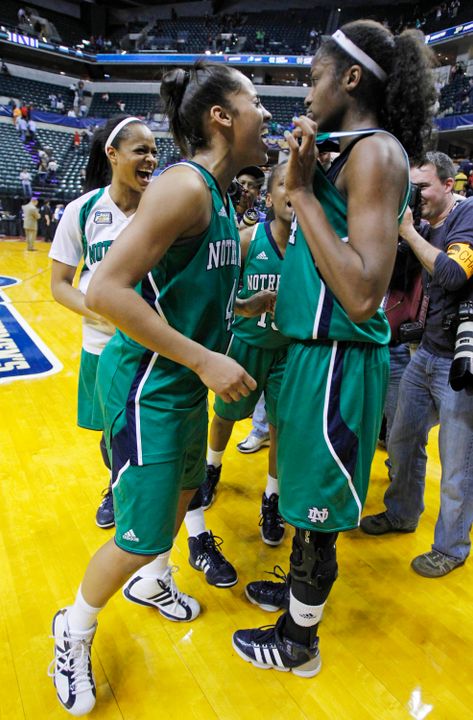April 5, 2011
INDIANAPOLIS (AP) – Why read a book if you already know how it ends?
Over the last 16 years, women’s college basketball has been more like a predictable, action-packed drama than a suspenseful thriller. Rarely has there been a surprise ending.
Notre Dame and Texas A&M changed that this year, knocking off all four top seeds on their way to the national championship game. It means Connecticut or Tennessee won’t be playing for the title for the first time in five years and the consensus around basketball seems to be: Good.
“It’s something new and fresh, which is a good sign,” UConn coach Geno Auriemma said.
If this seems unusual, it is, but Auriemma isn’t alone is suggesting the game will benefit from a jolt of new blood. And while it may seem shocking that none of the traditional powers are playing for a title, Notre Dame and Texas A&M didn’t come out of nowhere.
They were highly ranked all season, yet weren’t the teams anyone was picking to win a championship before the NCAA tournament – even though both were No. 2 seeds.
“I thought that was a good thing because we were able to fly under the radar,” Irish coach Muffet McGraw said. “I don’t think that anybody was talking about us. They were talking about the top four seeds the whole time. So it made it a little bit easier to come in and be the underdog, and to maybe get the upsets that we’ve had.”
Notre Dame, which won a championship in 2001 in its last trip to the Final Four, became the first team ever to knock off both Tennessee and Connecticut in the same tournament. Texas A&M bounced out sophomore phenom Brittney Griner and Baylor before the Aggies took out Stanford in the semifinals.
“Having two teams like Notre Dame and Texas A&M – given the teams they’ve beaten to get there – makes it even more compelling,” Auriemma said. “It’s not like they just snuck in and don’t deserve to be there.”
The plot for any good championship always seems to include a superstar like Griner or UConn’s Maya Moore, but this year’s matchup has that, too. Irish point guard Skylar Diggins is a dynamic leader on the court and an entertaining, well-spoken ambassador off the court, even though she’s just a sophomore. She gained nearly 20,000 Twitter followers overnight after her Irish beat UConn.
Still, this year was only the second time no top seed made the title game and the first since No. 3 seed North Carolina beat No. 4 Louisiana Tech in 1994.
“Sometimes, you have to go through growing pains to get to where we want to be – parity – where people would be excited where a Butler and a VCU are playing for the national championship on the men’s side,” Texas A&M coach Gary Blair said. “We need that on the women’s side as well.”
Still, the question remains whether the women’s tournament, which is in its 30th year, is ready to support that.
“Can a good women’s basketball game that’s going to be played between the ears and below the rim excite the people out there enough to watch this thing?” Blair mused.
The answer could be yes.
ESPN has been covering the women’s tournament exclusively for the past 16 years. Surprisingly, it’s most watched game had neither Tennessee or Connecticut in it.
“Our highest rated game was the Purdue game in 1999,” ESPN Vice president of programming and acquisitions Carol Stiff said. “It’s an event for us. We just pick up the pieces and run with whoever plays.”
The Boilermakers beat Duke that year in what turned out to be a rare matchup: Connecticut and Tennessee have combined to win 12 of the past 16 championships, including the last four.
On the men’s side, it’s not unusual to see powerhouse programs like Duke, Kansas, North Carolina, UCLA and Kentucky in the Final Four. But the title game has been won by teams seeded third, fourth, sixth and even eighth (Villanova). No. 8 seed Butler tried again this year, falling short to UConn but giving the little guys everywhere hope.
It might still be a while before that happens regularly on the women’s side, where the talent pool isn’t deep enough for widespread parity and top programs tend to have their great players for four years.
Auriemma knows that having someone else win keeps people interested, comparing it to golf.
“There’s got to be hope,” he said. “Everyone was sick of Tiger (Woods) winning all those tournaments. Once he shows up, everyone is coming in second or third. Now he shows up and people think, ‘We can beat this guy.’ I think the more that happens, the better it is.”







